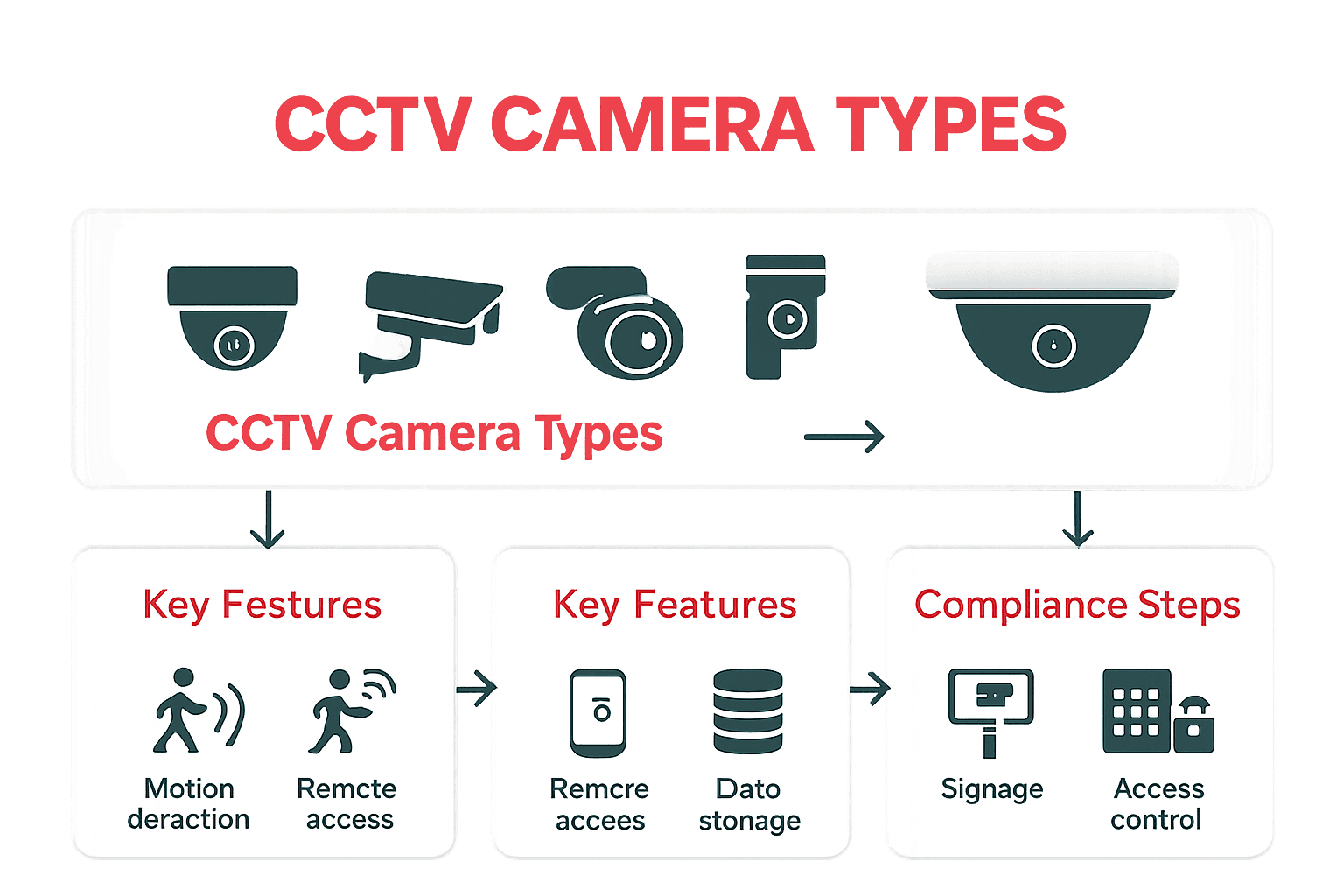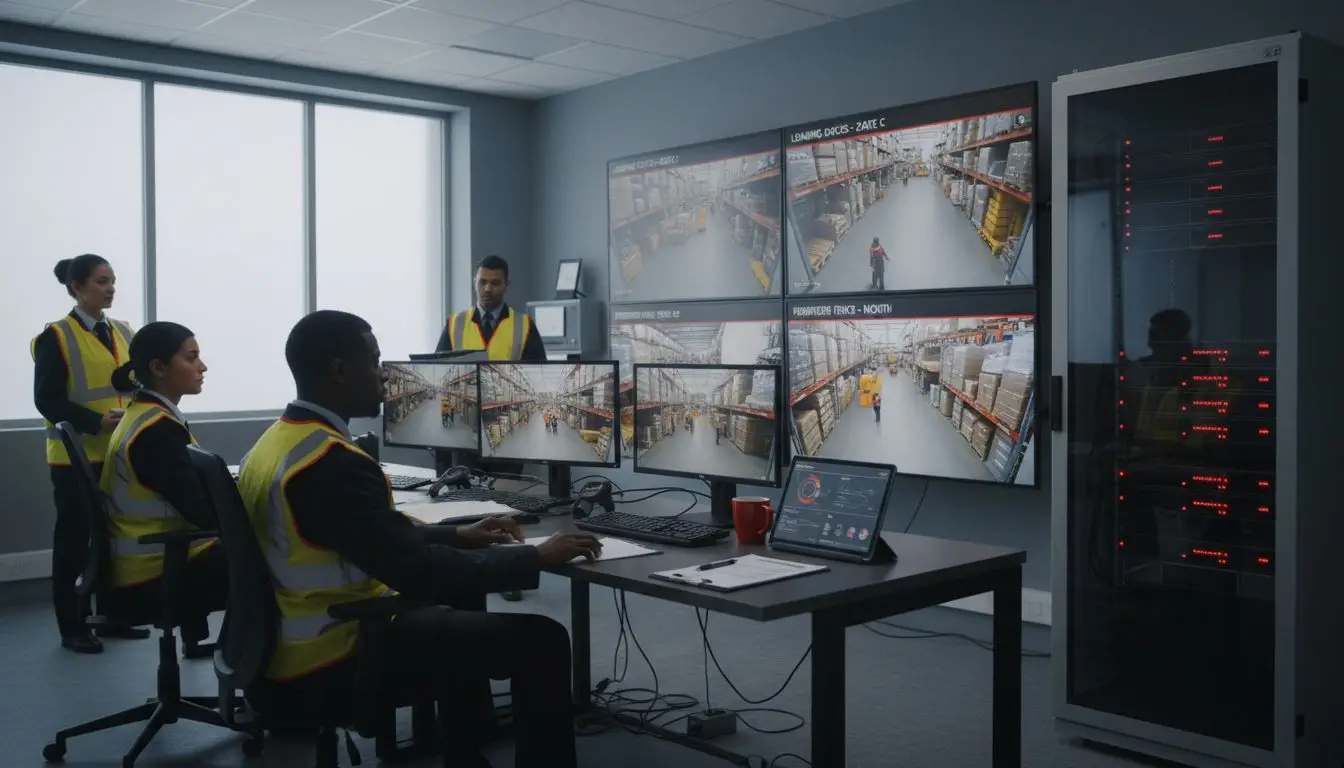Around 60 percent of warehouse thefts take place due to gaps in security coverage, putting valuable inventory and sensitive data at risk. Upgrading to a comprehensive warehouse CCTV system helps businesses not only deter theft but also improve workplace safety and oversee daily operations. With advanced technology, these systems offer real-time monitoring, smart analytics, and peace of mind that manual checks or simple locks cannot match.
Key Takeaways
| Point | Details |
|---|---|
| Comprehensive Surveillance Solutions | Warehouse CCTV systems are advanced security tools that provide real-time monitoring, ensuring asset protection and operational efficiency. |
| Legal Compliance Essentials | Businesses must adhere to UK regulations regarding privacy, data protection, and surveillance practices to ensure lawful CCTV usage. |
| Technological Integration | Modern CCTV systems incorporate various camera types and advanced features such as remote monitoring and AI, enhancing security management capabilities. |
| Strategic Installation Practices | Effective camera positioning and regular maintenance are critical for optimizing surveillance effectiveness while respecting individual privacy rights. |
Warehouse CCTV Systems Defined and Explained
Warehouse CCTV systems represent sophisticated security solutions designed to protect valuable assets, monitor inventory movements, and ensure workplace safety. These advanced surveillance networks go far beyond simple video recording, functioning as comprehensive security management tools that provide real-time monitoring and actionable insights.
According to gov.uk, effective surveillance camera systems must adhere to critical principles of proportionality, transparency, and accountability. This means warehouse managers must carefully design their CCTV installations to balance security needs with individual privacy rights, ensuring cameras are positioned strategically without unnecessarily intruding on employee personal spaces.
Warehouse CCTV systems typically incorporate multiple technological components to create robust security ecosystems:
- Fixed Cameras: Provide stable, wide-angle coverage of critical areas like entrances, loading docks, and high-value storage zones
- Pan-Tilt-Zoom (PTZ) Cameras: Allow dynamic monitoring with remote directional control
- Infrared Cameras: Enable clear monitoring during low-light conditions
- Motion-Triggered Cameras: Activate recording only when detecting movement, conserving storage resources
Modern warehouse CCTV solutions integrate sophisticated features like remote monitoring, cloud storage, and advanced analytics. These systems can track employee movements, detect unauthorized access, monitor inventory handling, and even provide insights into operational efficiency. By transforming raw video footage into intelligent security data, warehouse managers gain unprecedented visibility into their operational environments.
When implementing a warehouse CCTV system, businesses must consider multiple factors including camera placement, legal compliance, storage requirements, and technological integration. Warehouse Security involves a holistic approach that combines technological solutions with strategic planning to create comprehensive protection strategies.
Essential Types of Warehouse CCTV Cameras
Warehouse security demands sophisticated camera technologies that go beyond traditional surveillance methods. Understanding the essential types of CCTV cameras allows businesses to create comprehensive security strategies tailored to their specific operational environments and protection requirements.
Fixed dome cameras represent a fundamental component of warehouse security systems. These versatile devices offer discreet, wide-angle coverage and are particularly effective in monitoring large open spaces like storage areas, loading docks, and entry points. Their vandal-resistant design ensures continuous monitoring even in challenging industrial environments. CCTV Cameras Have Grown Up highlights how modern camera technologies have transformed surveillance capabilities.
Warehouse CCTV camera types include:
- Dome Cameras: Provide 360-degree coverage with tamper-resistant design
- Bullet Cameras: Excellent for long-distance monitoring of perimeter areas
- PTZ (Pan-Tilt-Zoom) Cameras: Allow remote directional control and detailed zoom capabilities
- Thermal Cameras: Detect heat signatures, enabling night-time and low-visibility monitoring
- IP Network Cameras: Offer digital integration and remote access capabilities
Infrared and thermal imaging cameras represent advanced technological solutions for warehouses with complex monitoring requirements. These specialized cameras can detect movement and temperature variations, providing critical security insights during low-light conditions or in areas with limited visibility. By integrating multiple camera types, warehouse managers can create multi-layered security environments that address potential vulnerabilities from different technological perspectives.

Selecting the right combination of camera technologies requires careful assessment of specific warehouse characteristics, including physical layout, inventory types, and potential security risks.
 6 Key CCTV System Features to Look For provides additional guidance on choosing optimal surveillance solutions that balance technological sophistication with practical security needs.
6 Key CCTV System Features to Look For provides additional guidance on choosing optimal surveillance solutions that balance technological sophistication with practical security needs.
Key Features and How CCTV Works
CCTV systems represent sophisticated technological networks that transform raw visual data into intelligent security solutions. At their core, these systems combine advanced hardware and software technologies to capture, process, and analyze surveillance footage, providing warehouses with comprehensive monitoring capabilities far beyond simple video recording.
Complete Guide to the Role of CCTV Monitoring highlights the intricate mechanisms that enable modern CCTV systems to function effectively. The fundamental workflow involves several critical components working in seamless coordination:
Key operational features of CCTV systems include:
- Image Capture: High-resolution cameras converting visual information into digital signals
- Data Transmission: Secure networks transferring footage to central recording devices
- Storage Management: Digital storage systems preserving video data
- Remote Access: Cloud-based platforms enabling real-time monitoring from multiple devices
- Motion Detection: Intelligent algorithms identifying and flagging unusual movements
The technological infrastructure of CCTV systems involves complex signal processing. Cameras convert optical images into electronic signals, which are then digitized, compressed, and stored using advanced encoding technologies. Modern IP-based systems leverage network protocols to transmit data securely, allowing instantaneous access and analysis. This means warehouse managers can monitor multiple locations simultaneously, receiving instant alerts about potential security breaches or operational anomalies.
Advanced CCTV technologies now integrate artificial intelligence and machine learning, enabling predictive analytics and sophisticated threat detection. 7 Essential CCTV Features List for Secure Properties demonstrates how contemporary surveillance systems have evolved from passive recording tools to proactive security management platforms that can anticipate and mitigate potential risks before they escalate.
UK Laws and Compliance for Warehouse Surveillance
Warehouse surveillance in the United Kingdom operates within a complex legal framework designed to balance security needs with individual privacy rights. Business owners must navigate intricate regulations that govern the deployment, operation, and management of CCTV systems to ensure legal compliance and protect both organizational and individual interests.
According to gov.uk, the Surveillance Camera Code of Practice establishes critical principles for lawful CCTV usage, emphasizing transparency, proportionality, and accountability. These guidelines mandate that warehouse managers must demonstrate a clear justification for surveillance, ensure cameras are positioned to capture only necessary areas, and maintain a demonstrable security rationale for their monitoring activities.
Key legal compliance requirements for warehouse surveillance include:
- Data Protection Registration: Mandatory registration with the Information Commissioner’s Office (ICO)
- Clear Signage: Prominent warning signs indicating active surveillance areas
- Restricted Access: Limiting video footage access to authorized personnel
- Retention Policies: Implementing strict data storage and deletion protocols
- Individual Rights: Respecting employees’ and visitors’ rights to access their recorded data
CCTV Regulations in Essex highlights the critical legal nuances that warehouse managers must understand. As per sprintlaw.co.uk, businesses must rigorously comply with UK GDPR and the Data Protection Act 2018. This includes conducting comprehensive Data Protection Impact Assessments, ensuring transparent communication about surveillance practices, and implementing robust security measures to protect recorded footage from unauthorized access or potential breaches.
The legal landscape surrounding warehouse surveillance continues to evolve, with increasing emphasis on balancing security imperatives with individual privacy protections. Warehouse managers must stay informed about regulatory changes, regularly review their surveillance strategies, and maintain meticulous documentation of their security protocols to demonstrate ongoing legal compliance.
Installation, Maintenance, and Common Pitfalls
Warehouse CCTV installation represents a complex process that requires meticulous planning, technical expertise, and strategic decision-making. Successful implementation goes far beyond simply mounting cameras, demanding a comprehensive approach that considers technological capabilities, physical infrastructure, and operational requirements.
Camera Placement Strategy emerges as the most critical factor in effective warehouse surveillance. Professional installers must conduct thorough site surveys, identifying potential blind spots, high-risk areas, and optimal mounting positions that maximize coverage while maintaining legal compliance. Key considerations include avoiding direct views of private spaces, ensuring adequate lighting conditions, and creating overlapping camera fields to eliminate potential security gaps.
Critical installation and maintenance steps include:
- Initial Site Assessment: Comprehensive evaluation of warehouse layout and security requirements
- Equipment Selection: Choosing cameras compatible with specific environmental conditions
- Precise Positioning: Strategic camera placement to maximize surveillance effectiveness
- Cable Management: Securing and protecting network and power infrastructure
- Regular Calibration: Periodic system testing and performance optimization
sprintlaw.co.uk warns that businesses should avoid excessive monitoring, particularly in areas where individuals maintain a reasonable expectation of privacy. This means warehouse managers must carefully balance comprehensive security with respect for personal boundaries, regularly reviewing and updating their surveillance policies to ensure ongoing legal and ethical compliance.
Common pitfalls in warehouse CCTV implementation include inadequate technical expertise, poor system design, and insufficient ongoing maintenance. Successful surveillance strategies require continuous professional support, including regular system updates, firmware upgrades, and comprehensive performance audits. Warehouse managers must treat their CCTV system as a dynamic security ecosystem, not a static technological installation, continuously adapting to evolving operational needs and technological advancements.
Strengthen Your Warehouse Security with Expert CCTV Solutions
The article highlights the challenges of balancing comprehensive warehouse surveillance with legal compliance and operational efficiency. Ensuring strategic camera placement, respecting privacy laws, and integrating advanced CCTV technologies are key concerns for any warehouse manager. If you are facing difficulties managing surveillance within these complex parameters or want to upgrade your system to avoid common pitfalls like poor maintenance or blind spots, professional support is essential.
At 247 CCTV, we specialise in installing tailored CCTV systems that not only meet stringent UK regulations but also enhance your security infrastructure with cutting-edge features. CCTV Cameras Have Grown Up and now provide intelligent monitoring that safeguards your assets while respecting employee privacy.
Discover how our expert team can transform your warehouse surveillance from a simple camera setup to a fully integrated security solution with remote access, motion detection and reliable data storage. Visit our homepage to explore our services and let us help you secure your warehouse with confidence.
Are you ready to take control of your warehouse security today

Contact us now to arrange a bespoke CCTV installation that complies with UK laws and protects what matters most. Don’t wait until vulnerabilities turn into costly breaches. Visit 247 CCTV for trusted security solutions made for your business.
Frequently Asked Questions
What are the main components of a warehouse CCTV system?
Warehouse CCTV systems typically include fixed cameras, pan-tilt-zoom (PTZ) cameras, infrared cameras, and motion-triggered cameras. These components work together to provide comprehensive coverage of critical areas within the warehouse.
How do I ensure legal compliance when installing a CCTV system in a warehouse?
To ensure legal compliance, businesses must register with the Information Commissioner’s Office (ICO), provide clear signage indicating areas under surveillance, restrict access to recorded footage, and implement strict data retention policies.
What factors should I consider when choosing CCTV cameras for my warehouse?
Consider the physical layout of the warehouse, the types of inventory being stored, potential security risks, and the technical capabilities of the cameras, such as resolution, night vision, and remote access features.
How can modern CCTV technology enhance warehouse security?
Modern CCTV technology enhances warehouse security through features such as remote monitoring, data analytics, and artificial intelligence. These advancements allow for real-time insights, detection of unauthorized access, and improved overall operational efficiency.

